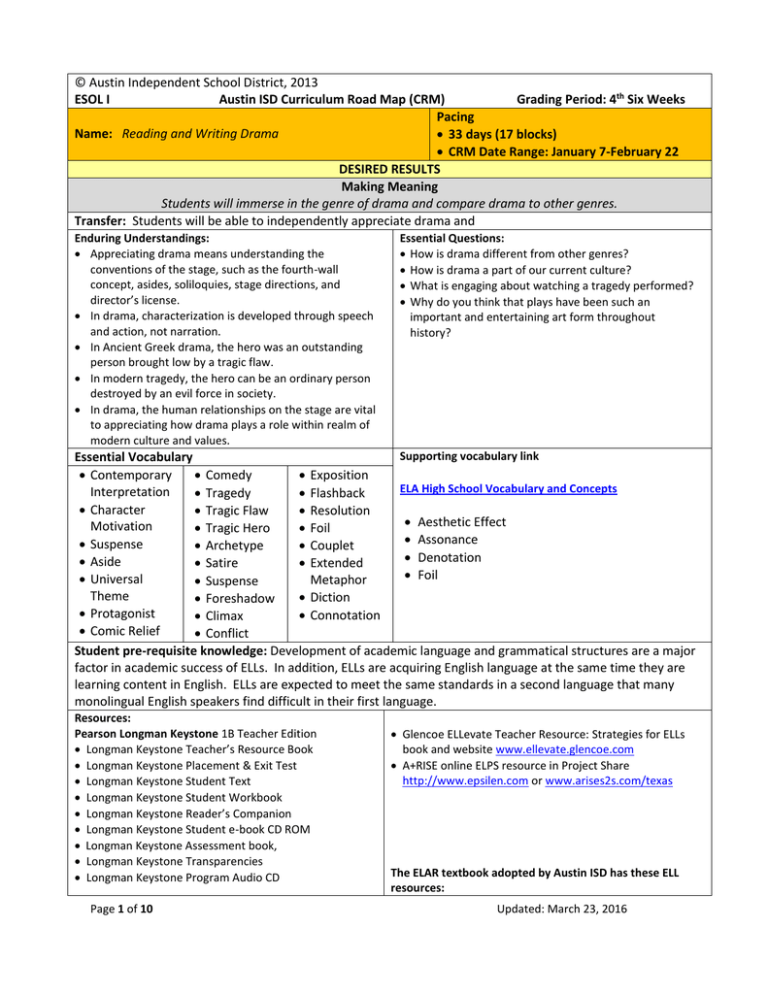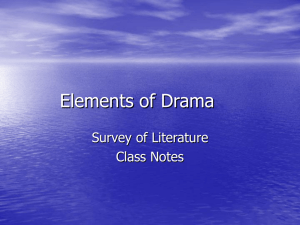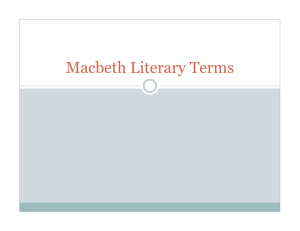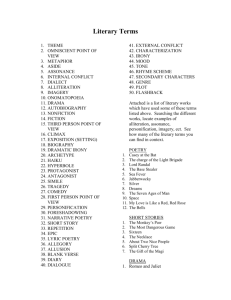
© Austin Independent School District, 2013
ESOL I
Austin ISD Curriculum Road Map (CRM)
Grading Period: 4th Six Weeks
Pacing
Name: Reading and Writing Drama
33 days (17 blocks)
CRM Date Range: January 7-February 22
DESIRED RESULTS
Making Meaning
Students will immerse in the genre of drama and compare drama to other genres.
Transfer: Students will be able to independently appreciate drama and
Enduring Understandings:
Appreciating drama means understanding the
conventions of the stage, such as the fourth-wall
concept, asides, soliloquies, stage directions, and
director’s license.
In drama, characterization is developed through speech
and action, not narration.
In Ancient Greek drama, the hero was an outstanding
person brought low by a tragic flaw.
In modern tragedy, the hero can be an ordinary person
destroyed by an evil force in society.
In drama, the human relationships on the stage are vital
to appreciating how drama plays a role within realm of
modern culture and values.
Essential Questions:
How is drama different from other genres?
How is drama a part of our current culture?
What is engaging about watching a tragedy performed?
Why do you think that plays have been such an
important and entertaining art form throughout
history?
Supporting vocabulary link
Essential Vocabulary
Contemporary
Comedy
Exposition
ELA High School Vocabulary and Concepts
Interpretation
Tragedy
Flashback
Character
Tragic Flaw
Resolution
Aesthetic Effect
Motivation
Tragic Hero
Foil
Assonance
Suspense
Archetype
Couplet
Denotation
Aside
Satire
Extended
Foil
Universal
Metaphor
Suspense
Theme
Diction
Foreshadow
Protagonist
Connotation
Climax
Comic Relief
Conflict
Student pre-requisite knowledge: Development of academic language and grammatical structures are a major
factor in academic success of ELLs. In addition, ELLs are acquiring English language at the same time they are
learning content in English. ELLs are expected to meet the same standards in a second language that many
monolingual English speakers find difficult in their first language.
Resources:
Pearson Longman Keystone 1B Teacher Edition
Longman Keystone Teacher’s Resource Book
Longman Keystone Placement & Exit Test
Longman Keystone Student Text
Longman Keystone Student Workbook
Longman Keystone Reader’s Companion
Longman Keystone Student e-book CD ROM
Longman Keystone Assessment book,
Longman Keystone Transparencies
Longman Keystone Program Audio CD
Page 1 of 10
Glencoe ELLevate Teacher Resource: Strategies for ELLs
book and website www.ellevate.glencoe.com
A+RISE online ELPS resource in Project Share
http://www.epsilen.com or www.arises2s.com/texas
The ELAR textbook adopted by Austin ISD has these ELL
resources:
Updated: March 23, 2016
Longman Keystone Teacher e-book & Examview CD
Longman Keystone Video Program DVD
Longman Keystone Phonics Kit- includes flash cards, 5
student workbooks,2 readers A & B, 1 Teacher’s Edition
Six Traits of Writing pamphlet
Penguin Readers-18 readers
Online Success tracker and essay scorer
www.pearsonsuccessnet.com
Longman Keystone Texas website www.texasesol.com
and http://portal.mypearson.com/mypearson-login.jsp
Prentice-Hall Literature Reader’s Notebook English
Learner’s version (9, 10, 11, 12)
Prentice-Hall Literature Reader’s Notebook Spanish
version (9, 10, 11, 12)
Prentice-Hall Teacher’s Edition Language Central (9, 10,no
11 or 12)
www.PHLitOnline.com
Prentice Hall Literature Texas edition, (Selections by Grade,
Genre, and Lexile, English II Writing Resources,
Teacher-selected fiction
ELA curriculum documents and resources
ELPS: Mandated by Texas Administrative Code (19 TAC §74.4), click on the link for English Language Proficiency
Standards (ELPS) to support English Language Learners.
ARC # 1: Introduction to Genre
Arc Pacing: 5 Days (2.5 Blocks)
Targeted Vocabulary: Contemporary Interpretation, Character Motivation, Suspense, Aside, Universal Theme
Resources: English 1 TEKS, Texas college Center and Readiness Standards (CCRS), Technology Application TEKS
TEKS Knowledge & Skills
Acquisition Important knowledge and skills
STAAR: RC = Reporting Category; DC = Dual Coded
Students Will Know
Students Will Be Able To
Skills; Readiness Standard; Supporting Standard
Concepts are addressed in another unit.
E1.4 Reading/Comprehension of Literary Text/Drama. Students understand, make inferences and draw conclusions about
the structure and elements of drama and provide evidence from text to support their understanding.
Dramatists use particular
Read, understand, interpret and analyze
(4A) explain how dramatic conventions
strategies for their genre:
simple and complex scripts.
(e.g., monologues, soliloquies, dramatic
monologues, soliloquies, dramatic
irony) enhance dramatic text RC2
Compare drama to other genres.
irony to convey meaning.
Contribute to making meaning of drama
in a literature circle.
Read linguistically accommodated
content-area material with a decreasing
need for linguistic accommodations as
more English is learned.
Employing inferential skills such as
predicting, making connections between
ideas, inferences and conclusions from
text and graphic sources and finding
supporting text evidence commensurate
with content-area needs.
ARC # 2: Author’s Craft: Drama
Arc Pacing: 5 Days (2.5 Blocks)
Targeted Vocabulary: Comic Relief, Foil, Comedy, Tragedy, Tragic Flaw, Tragic Hero
Resources: : English 1 TEKS, Texas college Center and Readiness Standards (CCRS), Technology Application TEKS
TEKS Knowledge & Skills
Acquisition Important knowledge and skills
STAAR: RC = Reporting Category; DC = Dual Coded
Students Will Know
Students Will Be Able To
Skills; Readiness Standard; Supporting Standard
Concepts are addressed in another unit.
E1.2 Reading/Comprehension of Literary Text/Theme and Genre. Students analyze, make inferences and draw
conclusions about theme and genre in different cultural, historical, and contemporary contexts and provide evidence from
the text to support their understanding.
Experiences are universal and are
Identify, compare and contrast theme
(2A) analyze how the genre of texts with
portrayed in various genres
through different genres.
similar themes shapes meaning RC1
(2B) analyze the influence of mythic,
Page 2 of 10
through theme.
Identify attributes of mythic, classical,
Updated: March 23, 2016
classical and traditional literature on 20th
and 21st century literature RC2
(2C) relate the figurative language of a
literary work to its historical and cultural
setting RC2
There are specific attributes of
mythic, classical and traditional
literature.
Authors take inspiration from
older texts and use their
attributes to breathe life into their
own texts.
Figurative language is shaped by
culture and time period.
and traditional literature in 20th and 21st
century literature.
Analyze theme in a group setting and
individually.
Identify figurative language.
Explain how it portrays historical and
cultural setting.
Employee analytical skills such as
evaluating written information and
performing critical analyses
commensurate with content area and
grade level needs.
E1.4 Reading/Comprehension of Literary Text/Drama. Students understand, make inferences and draw conclusions about
the structure and elements of drama and provide evidence from text to support their understanding.
Dramatists use particular
Read, understand, interpret and analyze
(4A) explain how dramatic conventions
strategies for their genre:
simple and complex scripts.
(e.g., monologues, soliloquies, dramatic
monologues, soliloquies, dramatic
irony) enhance dramatic text RC2
Compare drama to other genres.
irony.
Dramatists also use writing
strategies other writers use in
their genres.
Contribute to making meaning of drama
in a literature circle.
Read linguistically accommodated
content-area material with a decreasing
need for linguistic accommodations as
more English is learned.
Employing inferential skills such as
predicting, making connections between
ideas, inferences and conclusions from
text and graphic sources and finding
supporting text evidence commensurate
with content-area needs.
E1.12 Writing/Literary Texts. Students use comprehension skills to analyze how words, images, graphics, and sounds work
together in various forms to impact meaning. Students will continue to apply earlier standards with greater depth in
increasingly more complex texts.
Successful literary scripts contain
Compare two media sources covering the
(12A) Compare and contrast how events
a theme and diction that creates a
same theme.
are presented and information is
mood
and
tone
appropriate
to
the
communicated by visual images(e.g.
Analyze how visual and sound techniques
meaning of the text.
graphic art, illustrations, news,
are used to convey a message.
photographs) versus non-visual texts
Words, images, graphics can
Use strategic learning techniques such as
RC2/RC3
impact meaning.
(12B) Analyze how messages in media are
conveyed through visual and sound
techniques (e.g. editing, reaction shots,
sequencing, background music)
(12C) Compare and contrast coverage of
the same event in various media (e.g.,
newspaper, television, documentaries,
blogs, internet)
(12D) Evaluate changes in formality and
tone within the same medium for specific
audiences and purposes RC2/RC3
Page 3 of 10
concept mapping, drawing, memorizing,
comparing, contrasting, and reviewing to
acquire basic grade-level vocabulary.
Employ analytical skills such as evaluating
written information and performing
critical analyses commensurate with
content area and grade level needs.
Listen to and derive meaning from a
variety of media such as audio tape,
video, DVD, and CD-ROM to build and
reinforce concept and language
attainment.
Updated: March 23, 2016
E1.14 Writing/Literary Texts. Students write literary texts to express their ideas and feelings about real or imagined
people, events, and ideas. Students are responsible for at least two forms of literary writing.
Successful literary scripts contain
Write a script that adheres to proper
(14C) write a script with an explicit or
format.
implicit theme and details that contribute
a theme and diction that creates a
to a definite mood or tone
mood and tone appropriate to the Use strategies they have studied in text
to improve their own writing.
meaning.
Narrate, describe, and explain with
increasing specificity and detail to fulfill
content-area writing needs as a more
English is acquired.
Write using a variety of gradeappropriate sentence lengths, patters
and connecting words to combine
phrases, clauses, and sentences in
increasingly accurate ways as more
English is acquired.
ARC # 3: Author’s Craft: Comparing Drama to Short Fiction
Arc Pacing: 10 Days (5 Blocks)
Targeted Vocabulary: Archetype, Satire, Suspense, Climax, Conflict, Foreshadow, Exposition, Flashback,
Resolution, Foil
Resources: : English 1 TEKS, Texas college Center and Readiness Standards (CCRS), Technology Application TEKS
TEKS Knowledge & Skills
Acquisition Important knowledge and skills
STAAR: RC = Reporting Category; DC = Dual Coded
Students Will Know
Students Will Be Able To
Skills; Readiness Standard; Supporting Standard
Concepts are addressed in another unit.
E1.4 Reading/Comprehension of Literary Text/Drama. Students understand, make inferences and draw conclusions about
the structure and elements of drama and provide evidence from text to support their understanding.
Dramatists use particular
Read, understand, interpret and analyze
(4A) explain how dramatic conventions
strategies for their genre:
simple and complex scripts.
(e.g., monologues, soliloquies, dramatic
monologues, soliloquies, dramatic
irony) enhance dramatic text RC2
Compare drama to other genres.
irony.
Dramatists also use writing
strategies other writers use in
their genres.
Contribute to making meaning of drama
in a literature circle.
Read linguistically accommodated
content-area material with a decreasing
need for linguistic accommodations as
more English is learned.
Employ inferential skills such as
predicting, making connections between
ideas, inferences and conclusions from
text and graphic sources and finding
supporting text evidence commensurate
with content-area needs.
E1.5 Reading/Comprehension of Literary Text/Fiction. Students understand, make inferences and draw conclusions about
the structure and elements of fiction and provide evidence from text to support their understanding.
Advanced plot structures include
Identify plot structures and begin to
(5A) analyze non-linear plot development
flashbacks,
parallel
plot.
incorporate these structures in their own
(e.g., flashbacks, foreshadowing, sub-plots,
fictional pieces.
parallel plot structures) and compare it to
Authors use various
linear plot development RC2
characterization strategies.
Appreciate complex characterization and
(5B) analyze how authors develop complex
yet believable characters in works of
fiction through a range of literary devices,
Page 4 of 10
Point of view affects which
characters know what.
Fiction writers use particular
writing strategies for their genre.
incorporate this strategy in own fictional
pieces.
Understand the nuance of different
points of view and use point of view as an
effective strategy in their own writing.
Updated: March 23, 2016
including character foils RC2
Fiction writers also use strategies
other writers use in their genres.
Contribute to making meaning of a
fictional text in a literature circle.
Employ inferential skills such as
predicting, making connections between
ideas, inferences and conclusions from
text and graphic sources and finding
supporting text evidence commensurate
with content-area needs.
(5C) analyze the way in which a work of
fiction is shaped by the narrator's point of
view RC2
(5D) demonstrate familiarity with works by
authors from non-English-speaking literary
traditions with emphasis on classical
literature
E1.14 Writing/Literary Texts. Students write literary texts to express their ideas and feelings about real or imagined
people, events, and ideas. Students are responsible for at least two forms of literary writing.
Reading good literature should
Write a real or imagined story that
(14A) write an engaging story with a wellinform good writing.
engages the reader through a believable
developed conflict and resolution,
conflict.
interesting and believable characters, and
Planning conflict and character
a range of literary strategies (e.g., dialogue,
motivation leads to engaging
Create true-to-life characters.
suspense) and devices to enhance the plot
reading.
Use writing strategies to engage, surprise
RC4
the reader.
Narrate, describe, and explain with
increasing specificity and detail to fulfill
content-area writing needs as a more
English is acquired.
Write using a variety of gradeappropriate sentence lengths, patterns
and connecting words to combine
phrases, clauses, and sentences in
increasingly accurate ways as more
English is acquired.
ARC # 4: Author’s Craft: Comparing Drama to Poetry
Arc Pacing: 10 Days (5 Blocks)
Targeted Vocabulary: Couplet, Assonance, Extended Metaphor, Diction, Connotation, Denotation, Aesthetic
Effect
Resources: : English 1 TEKS, Texas college Center and Readiness Standards (CCRS), Technology Application TEKS
TEKS Knowledge & Skills
Acquisition Important knowledge and skills
STAAR: RC = Reporting Category; DC = Dual Coded
Students Will Know
Students Will Be Able To
Skills; Readiness Standard; Supporting Standard
Concepts are addressed in another unit.
E1.3 Reading/Comprehension of Literary Text/Poetry. Students understand, make inferences and draw conclusions about
the structure and elements of poetry and provide evidence from text to support their understanding.
Poets use particular writing
Read, understand, interpret and analyze
(3A) analyze the effects of diction and
strategies for their genre: line
simple and complex poems.
imagery (e.g., controlling images,
structure, enjambment, etc.
figurative language, understatement,
Compare poetry to other genres.
overstatement, irony, paradox) in poetry
Poets use writing strategies other
Contribute to making meaning of poetry
RC2
writers use in their genres:
diction, controlling imagery,
figurative language,
understatement, overstatement,
irony, and paradox.
in a literature circle.
E1.4 Reading/Comprehension of Literary Text/Drama. Students understand, make inferences and draw conclusions about
the structure and elements of drama and provide evidence from text to support their understanding.
Page 5 of 10
Updated: March 23, 2016
(4A) explain how dramatic conventions
(e.g., monologues, soliloquies, dramatic
irony) enhance dramatic text RC2
Dramatist use particular strategies
for their genre: monologues,
soliloquies, dramatic irony.
Dramatists also use writing
strategies other writers use in
their genres.
Read, understand, interpret and analyze
simple and complex scripts.
Compare drama to other genres.
Contribute to making meaning of drama
in a literature circle.
Read linguistically accommodated
content-area material with a decreasing
need for linguistic accommodations as
more English is learned.
Employ inferential skills such as
predicting, making connections between
ideas, inferences and conclusions from
text and graphic sources and finding
supporting text evidence commensurate
with content-area needs.
E1.7 Reading/Comprehension of Literary Text/Sensory Language. Students understand, make inferences and draw
conclusions about how an author's sensory language creates imagery in literary text and provide evidence from text to
support their understanding.
Authors often use double
Locate places in text when authors use
(7A) explain the role of irony, sarcasm,
meanings,
irony, sarcasm and/or paradox.
and paradox in literary works RC2
Irony is a contradiction between
appearance and reality.
Mature readers read a text on two
levels – literal and symbolic.
Explain the effect that irony, sarcasm
and/or paradox have on the meaning of a
text.
Use irony, sarcasm, and paradox to
improve their writing.
Employ inferential skills such as
predicting, making connections between
ideas, inferences and conclusions from
text and graphic sources and finding
supporting text evidence commensurate
with content-area needs.
Develop and expand repertoire of
learning strategies such as reasoning
inductively or deductively, looking for
patterns in language, and analyzing
sayings and expressions.
E1.15 Writing/Expository and Procedural Texts. Students write expository and procedural or work-related texts to
communicate ideas and information to specific audiences for specific purposes.
There are organizational structures
Write expository and procedural texts.
(15Ai) effective introductory and
of Expository and Procedural texts.
concluding paragraphs and a variety of
Use rhetorical devices, thesis, and
sentence structures RC4/RC5
Rhetorical devices, thesis, and
transitions.
(15Aii) rhetorical devices, and transitions
between paragraphs RC4/RC5
(15Aiii) a controlling idea or thesis
RC4/RC5
(15Aiv) an organizing structure
appropriate to purpose, audience, and
context RC4/RC5
(15Av) relevant information and valid
Page 6 of 10
transitions are important to
consider.
Writer's strategies like rhetorical
devices and transitions help the
readers appreciate the writer's
message.
Write using a variety of gradeappropriate sentence lengths, patterns
and connecting words to combine
phrases, clauses, and sentences in
increasingly accurate ways as more
English is acquired.
The more focused the writing, the
more likely the reader will be
informed and engaged by the text.
Narrate, describe, and explain with
increasing specificity and detail to fulfill
content-area writing needs as a more
Updated: March 23, 2016
inferences RC4/RC5
Organization not only clarifies
meaning, it also serves to
emphasize meaning.
English is acquired.
The quality of a writer's evidence
will affect the efficacy of his or her
message.
Page 7 of 10
Updated: March 23, 2016
ASSESSMENT EVIDENCE
TEA mandate requires the use of linguistic accommodations for ELLs as determined by the LPAC.
Data is available from the LPAS (Language Proficiency Assessment System.)
Refer to http://www.tea.state.tx.us/student.assessment /accommodations.
Student Work Products/Assessment Evidence
Performance Tasks
Other Evidence (i.e. unit tests, open ended exams, quiz,
Choose from the tasks below based on ELL
proficiency level and your pacing.
essay, student work samples, observations, etc.)
MOY II Reading
Drama: F19B, 4, 4A
Persuasive: F19B, 8A, 9A, 9C, 10, 10A, 10B
Poem: F19B, 3, 3A
1B, 2A, 2C, 12, 12A, 12D
Students write a response to a piece of text:
they respond to questions: What do you
notice? How does the author move the plot in
this passage? How might the actor speak this
line?
In literature circles, use stage directions to
flesh out set and props, write a description
In literature circles, complete a graphic
organizer that details “Prop, How It Is Used,
and What It Shows.”
In literature, use a graphic organizer to keep
track of summaries of each act
Editing: 17A, 17Ai, 17Aiii, 17C, 18B, 18Bii, 19A
Create Frayer Models of new vocabulary found
in reading
Window: February 4-8
Enact a short scene for class
In literature circles, complete a graphic
organizer that details “Character, Dialogue, and
Reveals”
Eligible ELLs may use linguistic accommodations when taking SCAs
or other assessments. Refer to
http://www.tea.state.tx.us/student.assessment/accommodations/
Write a dramatic sequel to a play read for class
Write a processed expository essay or literacy
essay
Page 8 of 10
MOY II Writing:
Composition: 13B-D, 14A (Literary Essay)
Revising: 15Ai-15Av
Additional Suggestions for Assessment
Brief research unit—Drama Time Line
Students present a group directed speech
Updated: March 23, 2016
LESSON PLANNING TOOLS
Teacher Notes
1. Additional text selections at different lexile levels are available in the Resources section, p 2 of this CRM.
(See link: Prentice Hall Literature Texas edition, (Selections by Grade, Genre, and Lexile, English II Writing
Resources)
2. Several lessons are included for each arc. Choose lessons based on proficiency of your ELLs and pacing
considerations.
In the course of lesson planning, it is the expectation that teachers will include whole child considerations when
planning such as differentiation, special education, English language learning, dual language, gifted and talented, social
emotional learning, physical activity, and wellness.
ESOL Exemplar Lesson 1- Arc 1: Introduction to Genre: Literary Text/Drama. Longman Keystone 1B, Unit 4
Autobiography “Helen Keller: The Story of My Life”, Play exerpt “The Little Prince”, Short Story “ Ginger for the Heart“ pp.
T244A-T302 various short stories and unit activities
Suggested Pacing:
TEKS: 3, 3A, 4, 4A
ESOL Exemplar Lesson 2 – Arc 1: Longman Keystone 2A, Unit 5, pp. T334-347, ‘Structure and Elements of Drama’, from
“Romeo and Juliet,” Prentice-Hall Literature Reader’s Notebook English Learner’s version (grade 9) Elements of Drama pp.
290-292
Suggested Pacing: 1 week
TEKS: 4, 4A
ELA Exemplar Lesson 3 - Arc 1: Intro to Drama
Suggested Pacing: 1 Block
TEKS: 4 , 4A,
ESOL Exemplar Lesson 1 – Arc 2: Author’s Craft: Drama. Longman Keystone 1B, Autobiography “Helen Keller: The Story of
My Life”, Play exerpt “The Little Prince” , Short Story “ Ginger for the Heart“ pp. T244A-T302 various short stories and unit
activities
Suggested Pacing: 1 week
TEKS: 3, 3A, 4, 4A
ESOL Exemplar Lesson 2 – Arc 2: Author’s Craft: Drama. Prentice-Hall Literature Reader’s Notebook English Learner’s
version (grade 9). “The Tragedy of Romeo and Juliet” Act 1 pp. 303-306, Act II pp. 307-314, Act III pp. 315-318, Act IV pp.
319-322, Act V pp. 323-326
Suggested Pacing: 2 weeks
TEKS: 3, 3A, 4, 4A
ESOL Exemplar Lesson – Arc 3: Author’s Craft: Comparing Drama to Short Fiction. Longman Keystone 1B, Unit 4, Texas
Skill Builders, Elements of Drama pp. T307--T302, Play “To Capture the Wild Horse” pp. 312-314
Suggested Pacing: 2 weeks
TEKS: 3, 3A, 4, 4A, 14A
ELA Exemplar Lesson 3 - Arc 2: Author’s Craft: “Scrambled Speech/Move It”
Suggested Pacing: 2 Blocks
TEKS: 4, 12, 12C, 2, 4, 4A,
ESOL Exemplar Lesson – Arc 4: Author’s Craft: Comparing Drama to Poetry. Longman Keystone 1B, Unit 5 Texas
Skillbuilders “Poetry” pp. T386-391, Sonnet to My Brother a Soldier” p. T392, Ballard “A Lone Star at Last” p. T393,
Compare it to Shakespeare’s “Romeo and Juliet”
Prentice-Hall Literature Reader’s Notebook English Learner’s version (grade 9). “The Tragedy of Romeo and Juliet” Act 1 pp.
303-306, Act II pp. 307-314, Act III pp. 315-318, Act IV pp. 319-322, Act V pp. 323-326
Suggested Pacing: 1.5 weeks
TEKS: 3, 4A, 7, 15Aiv
Instructional Resources
www.starfall.com
Austin ISD ELL Academic Plan 2013-2014, Resources pp. 160-164. (hyperlink
Page 9 of 10
Updated: March 23, 2016
LESSON PLANNING TOOLS
Teacher Notes
1. Additional text selections at different lexile levels are available in the Resources section, p 2 of this CRM.
(See link: Prentice Hall Literature Texas edition, (Selections by Grade, Genre, and Lexile, English II Writing
Resources)
2. Several lessons are included for each arc. Choose lessons based on proficiency of your ELLs and pacing
considerations.
In the course of lesson planning, it is the expectation that teachers will include whole child considerations when
planning such as differentiation, special education, English language learning, dual language, gifted and talented, social
emotional learning, physical activity, and wellness.
takes you to aisdweb intranet)
www.eflnet.com
Navigating the ELPS in the English Language Arts and Reading Classroom:
www.pumarosa.com
Using the Standards to improve instruction for ELLs, (J. Seiditz).
www.daveseslcafe.com
English I STAAR Writing Resources
www.colorincolorado.com
Page 10 of 10
Updated: March 23, 2016






